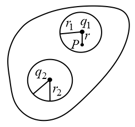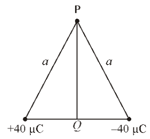Potential due to System of Charges
Potential due to System of Charges: Overview
This Topic covers sub-topics such as Electric Potential due to Two or More Charges at a Point
Important Questions on Potential due to System of Charges
Two point charges are separated by a distance of 1m in air. Calculate at what point on the line joining the two charges is the electric potential zero.
Two charges and are placed apart. The potential at point between them at a distance from on the line joining the two charges will be
Two concentric thin conducting spherical shell of radii and having charges and respectively. The electrostatic potential at point at distance from their common centre will be
is a square of side . Faqs changes ,, and are placed at the corners respectively calculate the electric potential at that intersection of diagonal is
Three point charges and are placed at the three vertices of an equilateral triangle of side length . The potential at the centre of triangle is
An uncharged conductor has two spherical cavities of radius and two point charges and are placed at centres of cavities. Potential at the surface of conductor is , then potential at point will be :-

Two point charges and are located at and respectively. Assume that the potential is vanishing at infinity. The correct statement about the surface (at finite distance) is:
The electric potential at point P owing to two or more point charges does not depend upon the distance between the point and the charge.
Determine the electric potential at point P owing to two point charges of charge , one at a distance and the other at a distance .
A unit positive charge has to be brought from infinity to a midpoint between two charges and separated by a distance of How much work will be required?
Three charges and respectively are placed on the vertices of an equilateral triangle of side. Calculate the electric potential at the centre of the triangle.
Four charges each is placed on four corners of a square of side . Find the potential at the centre of square.
A charge of is placed on each of the vertices of a regular hexagon of side , Find the electric potential at the centre of hexagon.
Two point charges, and are apart. At what points on the line joining the charges the electric potential is zero? Assume the electric potential to be zero at infinity.
Four charges, and respectively are placed on four corners of a square of edge . Find the electric potential at the centre of square.
For the arrangement of charges as shown in adjoining diagram, the work done in moving a charge from to (in joule) is

Two point charges of and are placed in free space apart. Find the electric potential at the middle point of the line joining the two charges.
Three charges , and are placed along a line as shown in the figure. The potential energy of the system is

The distance between two point charges is made of its initial value. The new potential energy between them will become
Cotyledons are also called-
